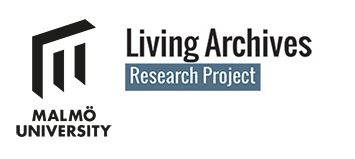In early June, researchers from the Living Archives gave presentations at the conference Things to Remember: Materializing Memories in Art and Popular Culture, organized by Radboud University, Nijmegen, The Netherlands.
Under the conference theme ‘Archives of Memory’, Susan Kozel gave a presentation entitled Somatic Archiving (see abstract below). Under the theme ‘Materializing the past in Urban Spaces’, Erling Björgvinsson gave the presentation City Symphony Malmö: The Spatio-material Politics of Non-institutional Memory.
Abstract – Somatic Archiving (Susan Kozel)
Initially a visceral response to speculative materialism, somatic materialism unfolds both in thought and in practice: in philosophical reflection, in artistic practice dealing with affect, and in somatic practices of attention and non-knowing (ref. Kozel, “Somatic Materialism” in Site Journal Issue 33, Stockholm 2013). With this conference paper I propose to open the somatic archiving dimensions of somatic materialism according to which archiving is a processural set of practices integrating devices and bodies replacing a construction of archives as a string of repositories or objects. This paper will draw upon the artistic research strand of Living Archives: the choreographic project AffeXity for which augmented reality (AR) and other ephemeral networked media applications are used to create choreographies of affect. These forms of fleeting but still recorded memories do (at least) two things simultaneously: they call attention to the many small, non-hierarchical and mediated acts of archiving and sharing that occur through mobile social media, and they reconfigure debates in performance studies that artificially separate the disappearance of the live from the mediation of the recorded. The performance of memory is as much about forgetting as about recalling, disappearance as reconstruction. Not an apologia for social media, in this paper a somatic and performative approach to archiving contributes another voice to the discussions of digital archiving, media archaeology, and memory.
View a longer extract of the paper.
Abstract – City Symphony Malmö (Erling Björgvinsson)
City Symphony Malmö was a collaborative documentary conceptualized by Erling Björgvinsson and Richard Topgaard. While building upon the early modernist tradition of city symphonies, it engaged citizens of Malmö in recording short film sequences that were uploaded to the City Symphony Malmö website. The Symphony was also performed at an art and performance center where musicians played to the VJ’s digital and analogue live mixing of the video material. A remediation of the performance was streamed live on the Internet. All clips were released under a Creative Commons license and was made available for remixing through The Pirate Bay. The production was an expression of the need for creating non-institutional memory and archiving practices and anti-monuments that critically engage with, and question, fixed, shared, and official memory practices (Björgvinsson and Høg Hansen 2011). We argue that City Symphony Malmö opened up for a Dingpolitik (after Latour 1993), advocating critical and passionate engagements with memory and the present. The Symphony could also be described as aesthetic processing (after Weibel 2000) steeped in distributed and networked memory practices. The paper will discuss the materialization of memories where the technical, social, and the imaginary intertwine to create a specific material terrain. It will do so by drawing upon public memory debates, on notions of socio-material politics of participation, and Lefebvre’s (1991) notion of the production of space.
The international conference Things to Remember: Materializing Memories in Art and Popular Culture took place on June 4–6 , 2014, at Radboud University, Nijmegen, The Netherlands. The organizers state: “From analyses of small things, including souvenirs, clothing, and objects from everyday life, to discussions of historical events such as the Holocaust and the Irish Famine, this conference will give you extensive access to the many different views on the relation between memory and materiality.”



